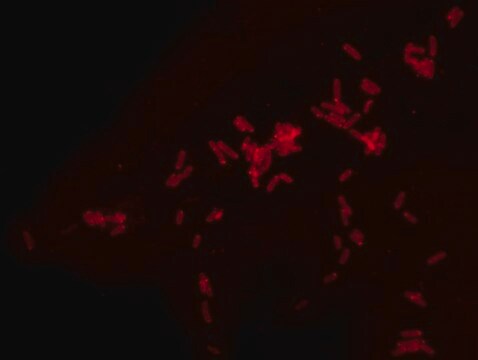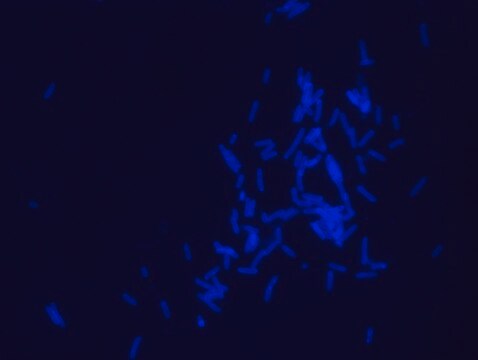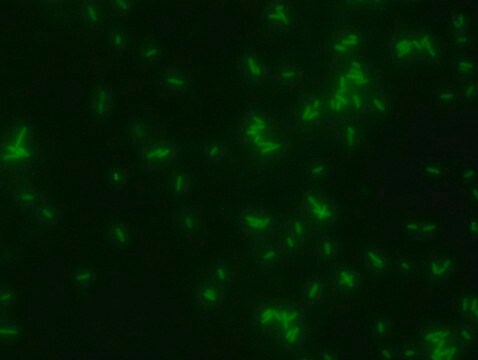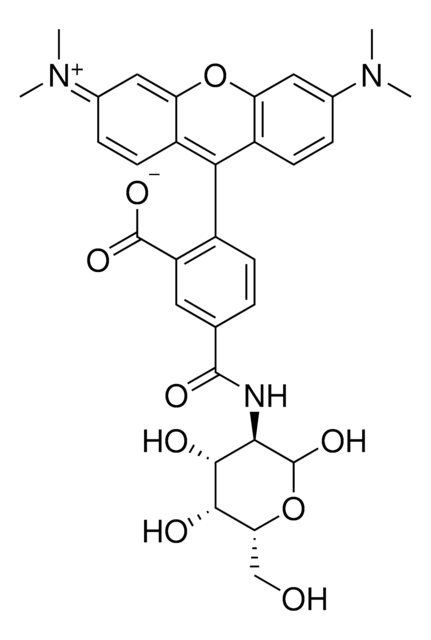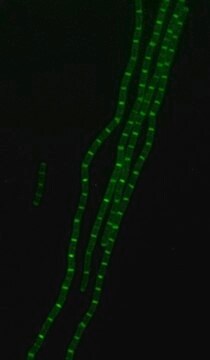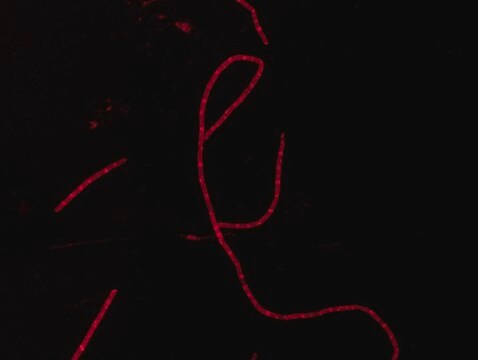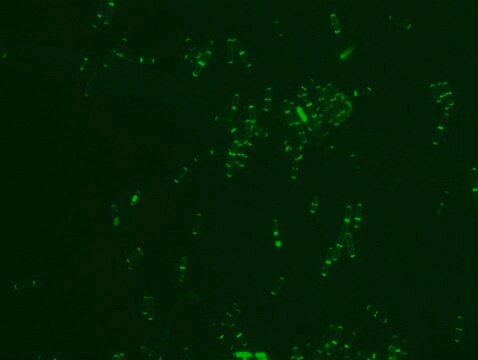SBR00069
Rhodamine labeled D-Lysine
Suitable for fluorescent microbial imaging
Sinonimo/i:
D-Lysine red, FDAA, TDL
Autenticatiper visualizzare i prezzi riservati alla tua organizzazione & contrattuali
About This Item
Formula empirica (notazione di Hill):
C31H34N4O6
Numero CAS:
Peso molecolare:
558.62
Codice UNSPSC:
12352209
NACRES:
NA.21
Prodotti consigliati
Descrizione generale
Bacterial Peptidoglycan is a polymer consisting of sugars and amino acids, a mesh-like rigid layer that forms the cell wall. D-Amino Acids (D-AAs) are metabolically incorporated onto the bacterial cell wall by D,D-transpeptidase and/or L,D-transpeptidase. It was recently discovered that those transpeptidases catalyze the metabolic incorporation of exogenous D-AAs with almost no restriction of the side-chain identity. Modification of a D-AA with molecular fluorophores provides fluorescent D-amino acids that can efficiently label in situ peptidoglycan in diverse bacterial species. Rhodamine-Labeled D-lysine (TDL) is a fluorescent derivative of D-lysine that is obtained by a synthetic conjugation of D-lysine to the fluorophore. Rhodamine Labeled D-lysine has high biocompatibility and suitability for labeling peptidoglycans in live bacteria. Additionally, it can be used in tandem with other stains such as FITC-Labeled D-Alanine (SBR00049) to distinguish between different bacteria. Other compatible products useful for live staining include: Rhodamine B Labeled Polymyxin B, FITC Labeled D-Lysine, FITC Labeled Vancomycin and Dansyl Labeled Polymyxin B (SBR00036, SBR00050, SBR00028, SBR00029 and SBR00047).
Applicazioni
Fluorescent labeled D-AAs (FDAAs) can be used for many applications including:
- Bacterial cell wall morphology
- Bacterial cell wall formation or remodeling activity
- Bacterial viability/activity
- Identify bacterial activity on surfaces or in substances
- Differentiation between various bacterial strains according to their incorporation profile of different D amino acids and sugars
Risultati analitici
- Fluorescent microscopy application: Rhodamine Labeled D-lysine has excitation/emission wavelength range at 550/570 nm.
- The recommended working concentration in fluorescent microscopy imaging application is between 250 µM-500 µM in working medium.
- Aliquots of the DMSO solution can be stored at -20 °C, protected from light for at least one month.
Prodotti correlati
N° Catalogo
Descrizione
Determinazione del prezzo
Codice della classe di stoccaggio
11 - Combustible Solids
Classe di pericolosità dell'acqua (WGK)
WGK 3
Punto d’infiammabilità (°F)
Not applicable
Punto d’infiammabilità (°C)
Not applicable
Scegli una delle versioni più recenti:
Certificati d'analisi (COA)
Lot/Batch Number
It looks like we've run into a problem, but you can still download Certificates of Analysis from our Documenti section.
Se ti serve aiuto, non esitare a contattarci Servizio Clienti
Possiedi già questo prodotto?
I documenti relativi ai prodotti acquistati recentemente sono disponibili nell’Archivio dei documenti.
Yen-Pang Hsu et al.
Chemical science, 8(9), 6313-6321 (2017-10-11)
Fluorescent d-amino acids (FDAAs) enable efficient in situ labeling of peptidoglycan in diverse bacterial species. Conducted by enzymes involved in peptidoglycan biosynthesis, FDAA labeling allows specific probing of cell wall formation/remodeling activity, bacterial growth and cell morphology. Their broad application
Helene Botella et al.
mBio, 8(5) (2017-09-14)
Peptidoglycan (PG), a polymer cross-linked by d-amino acid-containing peptides, is an essential component of the bacterial cell wall. We found that a fluorescent d-alanine analog (FDAA) incorporates chiefly at one of the two poles in Mycobacterium smegmatis but that polar
Il team dei nostri ricercatori vanta grande esperienza in tutte le aree della ricerca quali Life Science, scienza dei materiali, sintesi chimica, cromatografia, discipline analitiche, ecc..
Contatta l'Assistenza Tecnica.